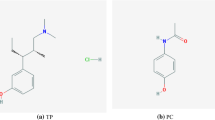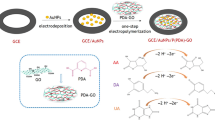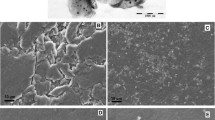Abstract
In this research, for the first time, an electrochemical sensor has been introduced by incorporating synthesized graphene nanoparticles (GrNPs) and tungsten disulfide nanoparticles (WS2NPs) into a carbon paste (CP) matrix. This sensor was used for the simultaneous measurement of noscapine (NOS) and papaverine (PAP) as two important alkaloids in opium. The properties of the synthesized nanoparticles were examined by scanning electron microscopy, elemental analysis, and X-ray diffraction. The electrochemical behavior of the modified electrode in aqueous solutions was studied by chronoamperometry, cyclic voltammetry, impedance, and differential pulse voltammetry techniques. A significant enhancement in the peak current response of NOS and PAP was observed at the graphene nanoparticles and tungsten disulfide nanoparticle–modified carbon paste electrode (GrNPs/WS2NPs/CPE) compared to the bare CPE. Also, using differential pulse voltammetry (DPV) method, linear range 5 to 1000 μM and limit of detection (LOD) (S/N = 3.0) 0.5062 μM and 1.0793 μM were obtained for NOS and PAP, respectively. Real-sample analysis results showed a recovery range 93.0–95.0% and 93.0–95.4 for NOS and PAP, respectively, that confirm a powerful ability of GrNPs/WS2NPs/CPE for determination of NOS and PAP in urine and industrial effluent samples.











Similar content being viewed by others
References
Liu H, Su D, Wang G, Qiao SZ (2012) WS2 anode material with superior electrochemical performance for lithium ion batteries. J Mater Chem 22:17437–17440. https://doi.org/10.1039/C2JM33992G
Yang G, Gong H, Liu T, Sun X, Cheng L, Liu Z (2015) Two-dimensional magnetic WS2@Fe3O4 nanocomposite with mesoporous silica coating for drug delivery and imaging-guided therapy of cancer. Biomaterials 60:62–71. https://doi.org/10.1016/j.biomaterials.2015.04.053
Li S, Jiang Z, Hou X, Xu J, Xu M, Yu X, Ma ZF, Yang J, Yuan X (2019) A relative study on sonochemically synthesized mesoporous WS2 nanorods & hydrothermally synthesized WS2 nanoballs towards electrochemical sensing of psychoactive drug (Clonazepam). Ultrason Sonochem 54:79–89. https://doi.org/10.1016/j.ultsonch.2019.02.012
Li Y (2022) Metal sulfide as catalysts enabling fast polysulfide conversion for high electrochemical performance Li–S batteries. Ionics. https://doi.org/10.1007/s11581-022-04493-8
Wang Y, Chen N, Du X, Zhang X (2021) Hierarchical sulfide nanoarrays as an efficient bifunctional electrocatalyst for overall water splitting. Ionics 27:2591–2602. https://doi.org/10.1007/s11581-021-04037-6
Mayorga-Martinez CC, Ambrosi A, Eng AYS, Sofer Z, Pumera M (2015) Transition metal dichalcogenides (MoS2, MoSe2, WS2 and WSe2) exfoliation technique has strong influence upon their capacitance. Electrochem Commun 56:24–28. https://doi.org/10.1016/j.elecom.2015.03.017
Yang H, Zhao F, Cao X, Liu Q, Zhang X, Zhang X (2020) Enhanced photoelectrocatalytic activity of cobalt sulfide modified with porphyrin as a noble-metal-free photoelectroncatalyst towards methanol oxidation under visible-light. J Taiwan Inst Chem Eng 116:169–177. https://doi.org/10.1016/j.jtice.2020.11.017
Gupta R, Valappil MO, Sakthivel A, Mathur A (2020) Tungsten disulfide quantum dots based disposable paper based lab on genochip for specific meningitis DNA detection. J Electrochem Soc 167:107501. https://doi.org/10.1149/1945-7111/ab8fda
Kozawa D, Carvalho A, Verzhbitskiy I, Giustiniano F, Miyauchi Y, Mouri S, Castro Neto A, Matsuda K, Eda G (2016) Evidence for fast interlayer energy transfer in MoSe2/WS2 heterostructures. Nano Lett 16:4087–4093. https://doi.org/10.1021/acs.nanolett.6b00801
Lei W, Xiao JL, Liu HP, Jia QL, Zhang HJ (2020) Tungsten disulfide: synthesis and applications in electrochemical energy storage and conversion. Tungsten 2:217–239. https://doi.org/10.1007/s42864-020-00054-6
Yang J, Voiry D, Ahn SJ, Kang D, Kim AY, Chhowalla M, Shin HS (2013) Two-dimensional hybrid nanosheets of tungsten disulfide and reduced graphene oxide as catalysts for enhanced hydrogen evolution. Angew Chemie Int Ed 52:13751–13754. https://doi.org/10.1002/anie.201307475
Foroughi MM, Jahani S, Aramesh-Boroujeni Z, Rostaminasab Dolatabad M, Shahbazkhani K (2021) Synthesis of 3D cubic of Eu3+/Cu2O with clover-like faces nanostructures and their application as an electrochemical sensor for determination of antiretroviral drug nevirapine. Ceramics Int 47:19727–19736. https://doi.org/10.1016/j.ceramint.2021.03.311
Setoudeh N, Jahani S, Kazemipour M, Foroughi MM, HassaniNadiki H (2020) Zeolitic imidazolate frameworks and cobalt-tannic acid nanocomposite modified carbon paste electrode for simultaneous determination of dopamine, uric acid, acetaminophen and tryptophan: Investigation of kinetic parameters of surface electrode and its analytical performance. J Electroanal Chem 863:114045. https://doi.org/10.1016/j.jelechem.2020.114045
Sheibani N, Kazemipour M, Jahani S, Foroughi MM (2019) A novel highly sensitive thebaine sensor based on MWCNT and dandelion-like Co3O4 nanoflowers fabricated via solvothermal synthesis. Microchem J 149:103980. https://doi.org/10.1016/j.microc.2019.103980
Arefi Nia N, Foroughi MM, Jahani S (2021) Simultaneous determination of theobromine, theophylline, and caffeine using a modified electrode with petal-like MnO2 nanostructure. Talanta 222:121563. https://doi.org/10.1016/j.talanta.2020.121563
Jijie R, Kahlouche K, Barras A, Yamakawa N, Bouckaert J, Gharbi T, Szunerits S, Boukherroub R (2018) Reduced graphene oxide/polyethylenimine based immunosensor for the selective and sensitive electrochemical detection of uropathogenic Escherichia coli. Sens Actuators B Chem 260:255–263. https://doi.org/10.1016/j.snb.2017.12.169
Wang X, Chen Y, Zheng B, Qi F, He J, Li P (2016) Few-layered WSe2 nanoflowers anchored on graphene nanosheets: a highly efficient and stable electrocatalyst for hydrogen evolution. Electrochim Acta 222:1293–1299. https://doi.org/10.1016/j.electacta.2016.11.104
Foroughi MM, Ranjbar M (2017) Microwave-assisted synthesis and characterization photoluminescence properties: a fast, efficient route to produce ZnO/GrO nanocrystalline. J Mater Sci: Mater Electron 28:1359–1363. https://doi.org/10.1007/s10854-016-5668-x
Lim JY, Mubarak N, Abdullah E, Nizamuddin S, Khalid MJ (2018) Recent trends in the synthesis of graphene and graphene oxide based nanomaterials for removal of heavy metals-A review. J Ind Eng Chem 66:29–44. https://doi.org/10.1016/j.jiec.2018.05.028
Li Y, Niu J, Xue T, Duan X, Tian Q, Wen Y, Lu X, Xu J, Lai L, Chang Y, Li Z, Zhao X, Chen Y (2020) Multifunctional porous nanohybrid based on graphene-like tungsten disulfide on poly(3,4-ethoxylenedioxythiophene) for supercapacitor and electrochemical nanosensing of quercetin. J Electrochem Soc 167:047512. https://doi.org/10.1149/1945-7111/ab721e
Er-Chieh C, Cai-Wan CJ, Jia-Huei Z, Jen-Hsien H, Kuen-Chan L, Bo-Cheng H, Yu-Sheng H (2018) Microwave-assisted synthesis of TiO2/WS2 heterojunctions with enhanced photocatalytic activity. J Taiwan Inst Chem Eng 91:489–498. https://doi.org/10.1016/j.jtice.2018.05.025
Shang X, Yan KL, Liu ZZ, Lu SS, Dong B, Chi JQ, Li X, Liu YR, Chai YM, Liu CG (2017) Oxidized carbon fiber supported vertical WS2 nanosheets arrays as efficient 3D nanostructure electrocatalyts for hydrogen evolution reaction. Appl Surf Sci 402:120–128. https://doi.org/10.1016/j.apsusc.2017.01.059
Cao S, Liu T, Hussain S, Zeng W, Peng X, Pan F (2014) Hydrothermal synthesis of variety low dimensional WS2 nanostructures. Mater Lett 129:205–208. https://doi.org/10.1016/j.matlet.2014.05.013
Latha M, Biswas S, Vatsala Rani J (2020) Application of WS2-G composite as cathode for rechargeable magnesium batteries. Ionics 26:3395–3404. https://doi.org/10.1007/s11581-020-03512-w
Mehew JD, Unal S, Torres Alonso E, Jones GF, Fadhil Ramadhan S, Craciun MF, Russo S (2017) Fast and highly sensitive ionic-polymer-gated WS2-graphene photodetectors. Adv Mater 29:1700222. https://doi.org/10.1002/adma.201700222
Chen SM, Umamaheswari R, Mani G, Chen TW, Ali MA, Fahad AH, Elshikh M, Farah MA (2018) Hierarchically structured CuFe2O4 ND@RGO composite for the detection of oxidative stress biomarker in biological fluids. Inorg Chem Front 5:944–950. https://doi.org/10.1039/C7QI00799J
United Nations (1987) Recommended methods for testing opium. United Nations, New York
Gerald MC (1974) Pharmacology: an introduction to drug. Prentice-Hall, Englewood Cliffs, NJ
Yan J, Mi JQ, He JT, Guo ZQ, Zhao M, Chang W (2005) Development of an indirect competitive ELISA for the determination of papaverine. Talanta 66:1005–1011. https://doi.org/10.1016/j.talanta.2005.01.001
Mashkovskii MD (2002) Lekarstvennye sredstva (Pharmaceutical preparations), vol 1. Novaya Volna, Moscow
Han X, Lamshoft M, Grobe N, Ren X, Fist AJ, Kutchan TM, Spiteller M, Zenk MH (2010) The biosynthesis of papaverine proceeds via (S)-reticuline. Phytochemistry 71:1305–1312. https://doi.org/10.1016/j.phytochem.2010.04.022
Huizer H (1987) Analytical studies on illicit heroin. Pharm Weekbl 9:203–211. https://doi.org/10.1007/BF02029331
Gough TA (1991) The examination of drugs in smuggling offences. In: Gough TA (ed) the analysis of drugs of abuse. John Wiley & Sons, Chichester, U.K., pp 511–566
Zhang S, Zhuang Y, Ju H (2004) Flow-injection chemiluminescence determination of papaverine using cerium(IV)-sulfite system. Anal Lett 37:143–155. https://doi.org/10.1081/AL-120027780
Zhuang YF, Cai XL, Yu JS, Ju HX (2004) Flow injection chemiluminescence analysis for highly sensitive determination of noscapine. J Photoch Photobiol A 162:457–462. https://doi.org/10.1016/S1010-6030(03)00391-5
Kasperek R (2008) Determination of diclofenac sodium and papaverine hydrochloride in tablets by HPLC method. Acta Pol Pharm Drug Res 65:403–408
Yin CH, Tang C, Wu XY (2003) HPLC determination of aminophylline, methoxyphenamine hydrochloride, noscapine and chlorphenamine maleate in compound dosage forms with an aqueous-organic mobile phase. J Pharm Biomed Anal 33:39–43. https://doi.org/10.1016/S0731-7085(03)00352-2
Tang Y, Luan J, Wang Q (2002) Determination of papaverine hydrochloride in skin and blood and the drug contents in pig skin. Acta Acad Med Sin 24:413–417
Ghasemi J, Niazi A, Ghorbani R (2006) Determination of trace amounts of lorazepam by adsorptive cathodic differential pulse stripping method in pharmaceutical formulations and biological fluids. Anal Lett 39:1159–1169. https://doi.org/10.1080/00032710600622126
Foroughi MM, Jahani S, Rajaei M (2019) Facile fabrication of 3D dandelion-like cobalt oxide nanoflowers and its functionalization in the first electrochemical sensing of oxymorphone: evaluation of kinetic parameters at the surface electrode. J Electrochem Soc 166:B1300. https://doi.org/10.1149/2.0511914jes
Fathabadi MV, Rafsanjani HH, Foroughi MM, Jahani S, Arefi Nia N (2020) Synthesis of magnetic ordered mesoporous carbons (OMC) as an electrochemical platform for ultrasensitive and simultaneous detection of thebaine and papaverine. J Electrochem Soc 167:027509. https://doi.org/10.1149/1945-7111/ab6446
Tajik S, Taher MA, Beitollahi H (2013) First report for simultaneous determination of methyldopa and hydrochlorothiazide using a nanostructured based electrochemical sensor. J Electroanal Chem 704:137–144. https://doi.org/10.1016/j.jelechem.2013.07.008
Chen TW, Rajaji U, Chen SM, Chinnapaiyan S, Ramalingam RJ (2019) Facile synthesis of mesoporous WS2 nanorods decorated N-doped RGO network modified electrode as portable electrochemical sensing platform for sensitive detection of toxic antibiotic in biological and pharmaceutical samples. Ultrason Sonochemistry 56:430–436. https://doi.org/10.1016/j.ultsonch.2019.04.008
Wang Y, Li Y, Tang T, Lu J, L J, (2009) Application of graphene-modified electrode for selective detection of dopamine. Electrochem Commun 11:889–892. https://doi.org/10.1016/j.elecom.2009.02.013
Wang Y, Jin Y, Pan E, Jia M (2018) Fe3O4 nanoparticle/grapheme aerogel composite with enhanced lithium storage performance. Appl Surf Sci 458:1035–1042. https://doi.org/10.1016/j.apsusc.2018.07.127
Krishnamoorthy D, Prakasam A (2021) Graphene hybridized with tungsten disulfide (WS2) based heterojunctions photoanode materials for high performance dye sensitized solar Cell device (DSSCs) applications. J Clust Sci 32:621–630. https://doi.org/10.1007/s10876-020-01828-1
Bard AJ, Faulkner LR (2001) Electrochemical methods: fundamentals and applications. Wiley, New York
Rezaei B, Heidarbeigy M, Ensafi AA, Dinari M (2015) Electrochemical determination of papaverine on Mg-Al layered double hydroxide/graphene oxide and CNT modified carbon paste electrode. IEEE Sens 16:3496–3503. https://doi.org/10.1109/JSEN.2016.2533429
Varsha K, Sharma A, Kaur A, Madan J, Pandey RS, Jain UK, Chandra R (2017) Nanostructures for cancer therapy; micro and nano technologies, chapter 28: natural plant-derived anticancer drugs nanotherapeutics: a review on preclinical to clinical success. Elsevier 775
Navaee A, Salimi A, Teymourian H (2012) Graphene nanosheets modified glassy carbon electrode for simultaneous detection of heroine, morphine and noscapine. Biosens Bioelectron 31:205–211. https://doi.org/10.1016/j.bios.2011.10.018
Nicholson RS, Shain I (1964) Theory of stationary electrode polarography. Single scan and cyclic methods applied to reversible, irreversible, and kinetic systems. Anal Chem 36:706–723. https://doi.org/10.1021/ac60210a007
Laviron E (1974) Adsorption, autoinhibition and autocatalysis in polarography and in linear potential sweep voltammetry. J Electroanal Chem 52:355–393
Rezaei B, Zare SZM (2008) Modified glassy carbon electrode with multiwall carbon nanotubes as a voltammetric sensor for determination of noscapine in biological and pharmaceutical samples. Sens Actuators B Chem 134:292–299. https://doi.org/10.1016/j.snb.2008.05.002
Babaei A, Sohrabi M (2016) An electrospun alumina-borate oxide nanofiber and reduced graphene oxide composite modified carbon paste electrode as the electrochemical sensor for simultaneous determination of dopamine and noscapine. Anal Methods 8:6949–6958. https://doi.org/10.1039/C6AY01724J
Ahammad A, Lee JJ, Rahman M (2009) Electrochemical sensors based on carbon nanotubes. Sensors 9:2289–2319. https://doi.org/10.3390/s90402289
Sharifi S, Zarei E, Asghari A (2021) Surfactant assisted electrochemical determination of noscapine and papaverine by TiO2 nanoparticles/multi-walled carbon nanotubes modified carbon paste electrode. Russ J Electrochem 57:183–196. https://doi.org/10.1134/S1023193521020129
Feng LJ, Zhang XH, Zhao DM, Wang SF (2011) Electrochemical studies of bovine serum albumin immobilization onto the poly-o-phenylenediamine and carbon-coated nickel composite film and its interaction with papaverine. Sens Actuators B Chem 152:88–93. https://doi.org/10.1016/j.snb.2010.09.031
Ziyatdinova G, Samigullin A, Budnikov G (2007) Voltammetric determination of papaverine and drotaverine. J Anal Chem 62:773–776. https://doi.org/10.1134/S1061934807080138
Kharitonov SV (2006) Electrochemical response characteristics and analytical application of papaverine ion-selective membrane electrodes. Anal lett 39:259–273. https://doi.org/10.1080/00032710500476912
Eppelsheim C, Aubeck R, Hampp N, Bräuchle C (1991) Determination of ethaverine and papaverine using ion-selective electrodes. Analyst 116:1001–1003. https://doi.org/10.1039/AN9911601001
Author information
Authors and Affiliations
Corresponding author
Ethics declarations
Conflict of interest
The authors declare no competing interests.
Additional information
Publisher's note
Springer Nature remains neutral with regard to jurisdictional claims in published maps and institutional affiliations.
Rights and permissions
Springer Nature or its licensor (e.g. a society or other partner) holds exclusive rights to this article under a publishing agreement with the author(s) or other rightsholder(s); author self-archiving of the accepted manuscript version of this article is solely governed by the terms of such publishing agreement and applicable law.
About this article
Cite this article
Ahmadi, E., Zarei, E. & Asghari, A. Electrochemical sensor based on graphene and tungsten disulfide nanoparticles for determination of noscapine and papaverine. Ionics 29, 1579–1591 (2023). https://doi.org/10.1007/s11581-023-04895-2
Received:
Revised:
Accepted:
Published:
Issue Date:
DOI: https://doi.org/10.1007/s11581-023-04895-2




